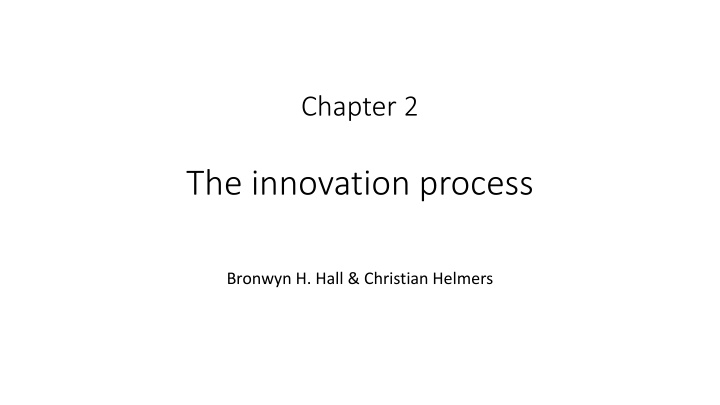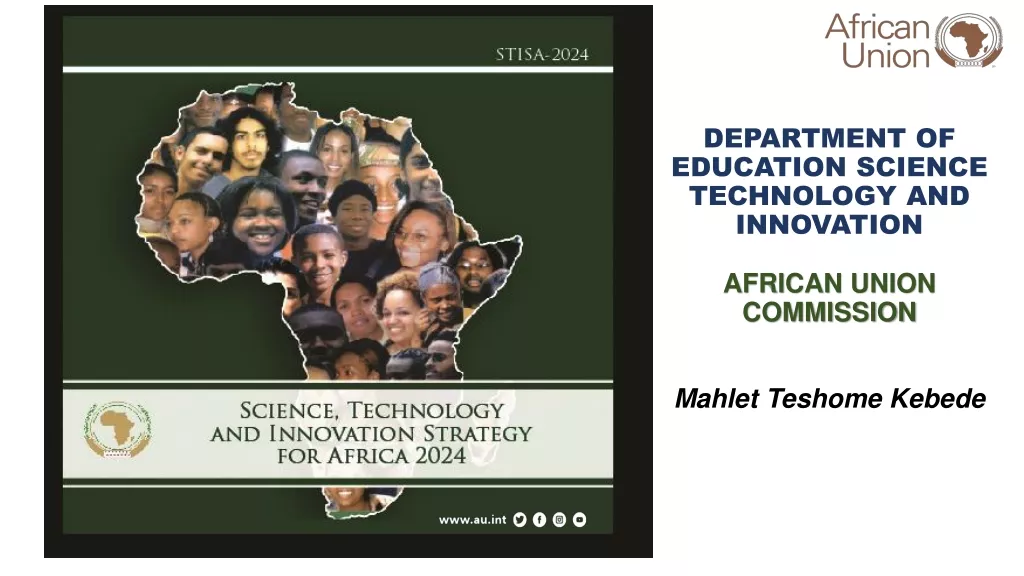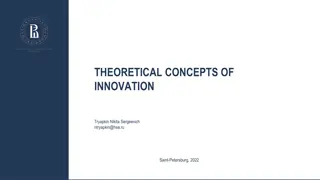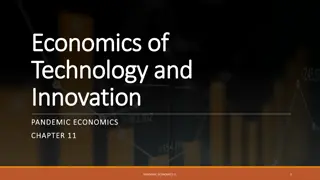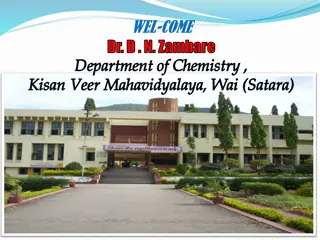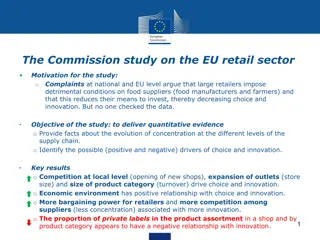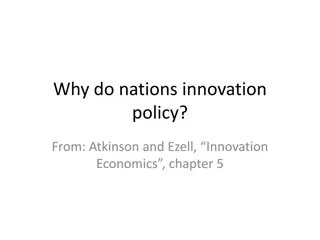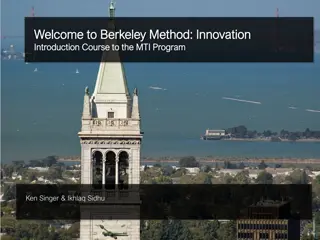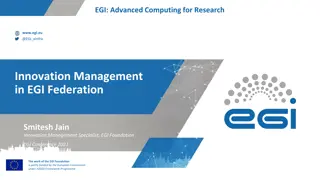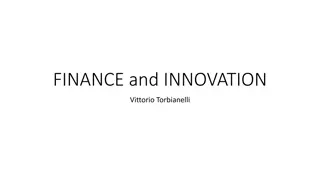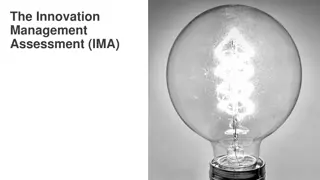The Innovation Process and Elements Explained
In this content, the innovation process is dissected, highlighting the importance of economic factors, chance, and unpredictability. It explores the linear model of innovation, feedback loops, and factors necessary for successful innovation. Additionally, it covers the elements of innovation such as invention, innovation, and diffusion, shedding light on their roles in societal progress. The text also delves into technological innovation stemming from R&D activities, emphasizing basic research, applied research, and experimental development as key components.
Download Presentation

Please find below an Image/Link to download the presentation.
The content on the website is provided AS IS for your information and personal use only. It may not be sold, licensed, or shared on other websites without obtaining consent from the author.If you encounter any issues during the download, it is possible that the publisher has removed the file from their server.
You are allowed to download the files provided on this website for personal or commercial use, subject to the condition that they are used lawfully. All files are the property of their respective owners.
The content on the website is provided AS IS for your information and personal use only. It may not be sold, licensed, or shared on other websites without obtaining consent from the author.
E N D
Presentation Transcript
Chapter 2 The innovation process Bronwyn H. Hall & Christian Helmers
Chapter overview Linear model of innovation and its critiques Science from technology Learning by doing and using Direction and types of innovation Innovation as a quasi-public good and the implications 2024 Hall & Helmers Ch. 2 2
4 insights about the innovation process: Economic factors are important for an understanding of the rate and direction of technical change, but chance and unpredictability often seen in the process. Innovation usually modeled as a linear process from science to end product, but there can be feedback from one stage to an earlier stage. Such feedback can be important to the eventual success of the innovation. Innovations frequently require a number of factors to come together before they are made; that is, the environment in which the innovation will come to life needs to have the necessary ingredients to make it effective: consumer demand for the innovation and the capabilities of necessary complementary products. Relevant science often a precondition for an innovation, but some innovations are made before the science that lies behind them is completely understood. 2024 Hall & Helmers Ch. 2 3
Elements of innovation Invention: creation of the idea of how to do or make something (usually done by an individual, sometimes a small team of individuals). an increment in the set of total technical knowledge of a given society (Mokyr 1992) prescription for a producible product or operable process so new as not to have been obvious to one skilled in the art at the time the idea was put forward (Schmookler 1966) Innovation: making an idea for a new product or process real, putting it into practice; includes development and commercialization; usually done by a team or company. Diffusion: the spread of a new invention/innovation throughout society or at least throughout the relevant part of society. 2024 Hall & Helmers Ch. 2 4
Technological innovation usually comes from R&D OECD Frascati Manual definitions (used by most statistical agencies) Basic Research: experimental/ theoretical work undertaken primarily to acquire new knowledge of the underlying foundations and phenomena and observable facts, without any particular application or use in view. Applied Research: original investigation undertaken in order to acquire new knowledge , directed primarily towards a specific practical aim or objective. Experimental Development: systematic work, drawing on existing knowledge gained from research and practical experience, directed to producing new materials, products and devices; to installing new processes, systems or services; to improving substantially those already produced or installed. 2024 Hall & Helmers Ch. 2 5
Linear model of innovation Stylized view of innovation as outcome of a linear process from basic research through to commercialization 2024 Hall & Helmers Ch. 2 6
Example: pharmaceutical innovation Basic research done by the firm itself, universities, and government laboratories. Applied research directed at specific disease; screening compounds in test tubes; testing compounds on animals. Development - series of clinical trials (Phase I, II, III) New Drug Application (NDA) submitted to regulatory agency for marketing approval if Phase III successful and drug expected to be profitable. Commercialization determine packaging and dosage information; scale up manufacturing; marketing drug to doctors and consumers. Diffusion - use of drug spreads throughout the relevant doctor and patient population. May also include process of satisfying regulators and adapting drug delivery in other countries. Note: Pharma innovation highly uncertain process; most compounds fail. 2024 Hall & Helmers Ch. 2 7
Example: software innovation Basic research - relies on mathematics and logic, sometimes quite old. connection to current research in these areas is rather remote and their importance depends on the particular application. Applied research - cryptography, sorting algorithms, data storage systems, and numerical methods important for software development. Invention - the concept of what a useful program would do and specification of its basic features. Development - creating detailed specifications, coding, and alpha testing. Commercialization - beta testing phase; marketing; successful sale. Diffusion persuading potential customers to adopt software feedback leading to modifications larger customer base finds problems that were not foreseen during development. A prolonged incremental process even after the first sales. 2024 Hall & Helmers Ch. 2 8
Comparing the examples Commonalities: Innovation in both industries rests on science, but different kinds Innovation created in response to perceived consumer demand Differences: Pharma Software Costs Highest in development Highest in diffusion Market share determined by Therapeutic indication and patent protection First to market, rapid diffusion Uncertainty Feasibility and regulatory response First to market, successful diffusion Innovation Stand-alone (to some extent) Modular Learning During development; some from patient use later During use by customers 2024 Hall & Helmers Ch. 2 9
Science from technology Linear model does not always apply Innovation leads to two broad types of scientific development: 1. Drive to understand why something works leads to new science. 2. Deliberate attempts to improve a technology that requires further understanding of the science behind it. Improvements in technology can make the science behind it more economically valuable and hence easier to pay for. Example: Louis Pasteur (19th century France) Worked for a vintner trying to improve the fermentation process of beetroot wine Traced the source of contamination to micro-organisms that could be eliminated by heating liquids to temperatures between 60 and 100 degrees Celsius. Scientific and technological advances: Contributed to germ theory of disease (basic science) Pasteurization (a commercial innovation) 2024 Hall & Helmers Ch. 2 10
Science from technology Feedback from applied research, innovation, and development to the science base. Key idea: technological knowledge often precedes scientific knowledge and that this leads to scientific developments that in turn improve technology. 2024 Hall & Helmers Ch. 2 11
Pasteurs quadrant: Applied and Basic Research 2024 Hall & Helmers Ch. 2 12
Instrumentation for science Better instrumentation (technology) can lead to progress in science One scientific or technological area can influence development of a completely different area via the provision of improved instrumentation. Examples: Success of Pasteur s use of microscope to observe fermentation and develop germ theory led to increased demand for microscopy improvements, which in turn aided scientific investigation. Development of huge superconducting magnets for the various particle accelerators such as the supercollider at CERN has led to improvements in materials science. Development of laser technology led to its use in greatly speeding up DNA sequencing beginning in the 1980s, facilitating scientific research in the biogenetic area. 2024 Hall & Helmers Ch. 2 13
Learning by doing Describes the process by which experience with a new technology leads to knowledge and productivity growth in its use. Accumulation of knowledge generated by production feeds into future productivity growth via enhanced capital goods. Learning curve: empirical regularity that a production process became more efficient as it is repeated, at a diminishing rate. Reasons why costs of production fall as experience is gained: Accumulation of experience by workers. Learning by management that leads to better organization of productive tasks, better timing in the ordering of parts, etc. Improvements in design or materials over time. 2024 Hall & Helmers Ch. 2 14
Learning by doing Models of the learning curve relate cost of producing the next unit of a complex product to number of such products already produced. Simplest model: log(c) = log(c0) - b log(y) c - unit cost of production y - past cumulative output b - elasticity of unit cost with respect to past output c0 - cost of producing the first unit. Elasticity b measures the per cent reduction in unit cost from a per cent increase in output: ? = ? log ? Implication of constant elasticity: magnitude of cost benefit from increased output declines as output grows. ? log ?= ??? ??? 2024 Hall & Helmers Ch. 2 15
Learning by doing Learning curve for laser diode made by Sony: log (price) = log (5038)- 0.373 log (shipments) The coefficient 0.373 implies that every time the past number of shipments doubles, unit cost falls 37%. 2024 Hall & Helmers Ch. 2 16
Learning by using Products are often improved, developed and enhanced based on experience of the product in use. Learning that takes place as a result of experience with using a new innovative product. Technological change and innovation do not end when the technology is diffused to users. Technologies continue to improve due to feedback from use and users. Feature of complex capital goods, whose performance is not fully understood until they are used. Learning by using also can contribute to product differentiation. 2024 Hall & Helmers Ch. 2 17
Learning by using example Evolution of Boeing aircraft (747) Many improvements made to planes after their first use: embodied - physical change to the good disembodied - changes to its maintenance or use Main improvement - longer and larger versions of the same model of aircraft as experience is gained in their use. Also other changes made in the form of engines, configurations, design for freight or particular customers. 2024 Hall & Helmers Ch. 2 18
Uncertainty and timing Striking feature of innovation: inability of inventors to forecast the ultimate implications and uses of their inventions. Some examples: Computers - forecast by Thomas Watson (CEO of IBM) in 1943 that the worldwide demand for his computers was likely to be only 5. Radio - Marconi envisioned narrowcasting (ship-to-ship communication) as the main use, not the broadcasting that is a major use today. Internet - ARPANET created for the U.S. Defense Department using distributed communication protocols as a defense against losing communication ability if a single node goes down. Multiple such networks linked during the 1970s to create a primitive internet. Commercial use did not really take off until Tim Berners-Lee at CERN combined the internet node system with hypertext to create the world wide web in 1989. 2024 Hall & Helmers Ch. 2 19
Uncertainty and timing Two related features of major inventions and their impact: Length of time between invention and its larger economic impact. Need for complementary inventions to enable the first invention have wider use: e.g., semiconductors in the case of computing and hypertext and personal computers in the case of the internet. Implications for risk: Ordinary risk associated with the process of research and invention. Uncertainty over true benefit of invention - very difficult to assess when it is undertaken. Sources of uncertainty: Technical risk: uncertainty over whether something will work and how it will work. Market risk: uncertainty over market demand. 2024 Hall & Helmers Ch. 2 20
General Purpose Technologies General Purpose Technologies (GPTs): technology with many different applications. To make them useful, GPTs usually require the reorganization of production; possibly also the broader economy. Slows diffusion Examples: steam engine, electricity, semiconductor, internet, artificial intelligence (AI). Diffusion often requires standards of interoperability for technology to spread across firms, sectors, and regions. 2024 Hall & Helmers Ch. 2 21
Direction of innovation What kinds of innovation are produced? What determines the direction of innovative activity? Innovations produced depend on: Ease of supply (technological opportunity) i.e. availability of science and technology needed Size of perceived demand Availability of intellectual property protection Public procurement 2024 Hall & Helmers Ch. 2 22
Types of innovation: Types of innovation: radical vs incremental Radical vs incremental: Incremental innovation: improvements in existing product/process that enhance performance or attractiveness to customers. e.g., the latest iPhone model Radical innovation: create entire new markets. e.g., the first automobile; first smartphones 2024 Hall & Helmers Ch. 2 23
Types of innovation: Types of innovation: Process and product innovation Product innovation: creation of a new good or service for sale (increases the firm's demand). Process innovation: new way of doing something (typically cost reducing). 2024 Hall & Helmers Ch. 2 24
Process and product innovation They often go together within a firm: 2024 Hall & Helmers Ch. 2 25
Process and product innovation The relative importance of process innovation varies across technologies. 2024 Hall & Helmers Ch. 2 26
User innovation Users themselves innovate, modifying a product to suit their needs. Examples: Sporting equipment, e.g. windsurfing, skateboarding, snowboarding equipment Open source software (OSS) Importance of lead users - those on the frontier in the use of the product, who discover needs that later users may also experience. User innovation widespread in industry with firm customers suggesting modifications to the capital goods they purchase. 2024 Hall & Helmers Ch. 2 27
Innovation as a quasi-public good Optimal allocation of resources to invention requires: Utility and production functions are well-defined functions of commodities. No uncertainty (now, or in the future, in production or consumer taste). Fails: innovation is highly risky Inputs and outputs are private property. Fails: innovative idea does not act like private property No indivisibility in production or consumption. Fails: innovation is discrete, once made, can be used an arbitrarily large number of times. Perfectly competitive markets unlikely to allocate enough resources to invention and innovation because of uncertainty, inappropriability, and indivisibility. Suggests need for policy designed to encourage innovation. 2024 Hall & Helmers Ch. 2 28
Summary Innovation: technological innovation that improves the welfare of society. Basic model: innovative process linear, from scientific base to commercialization of new products and processes. Along linear path, many feedback loops. Uncertainty and risk inherent in innovation. Knowledge created by innovative activity has quasi-public good characteristics, important implications for firm strategy and public policy. 2024 Hall & Helmers Ch. 2 29
